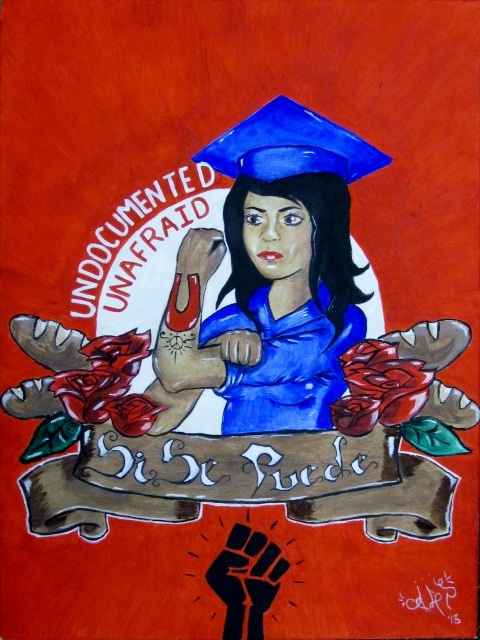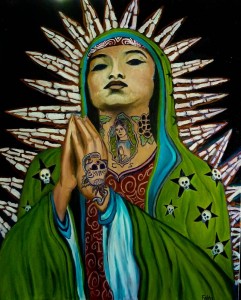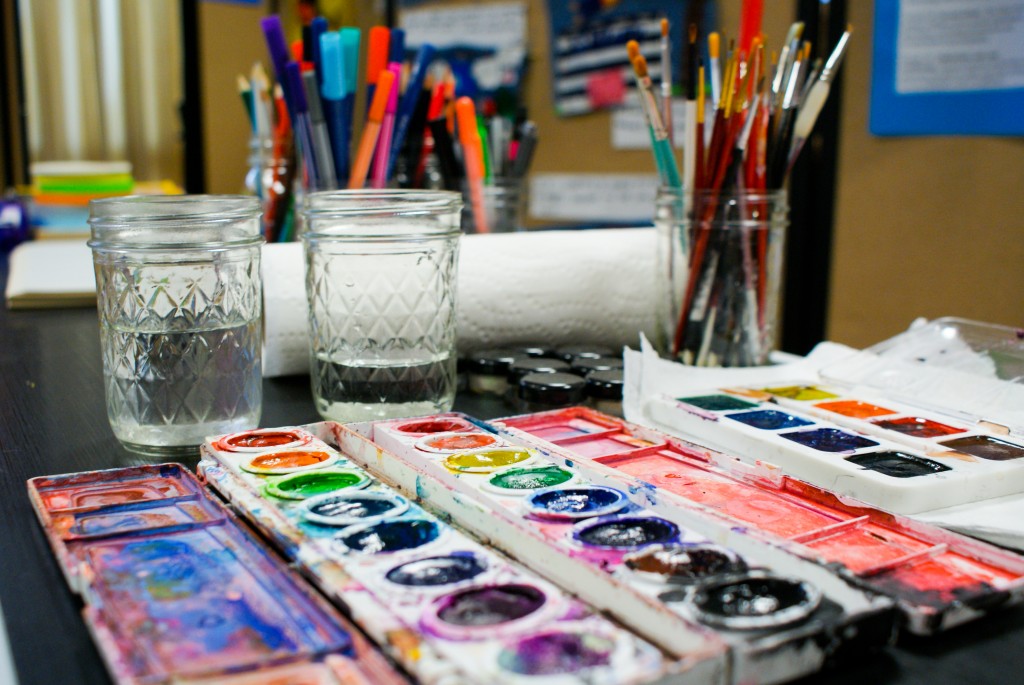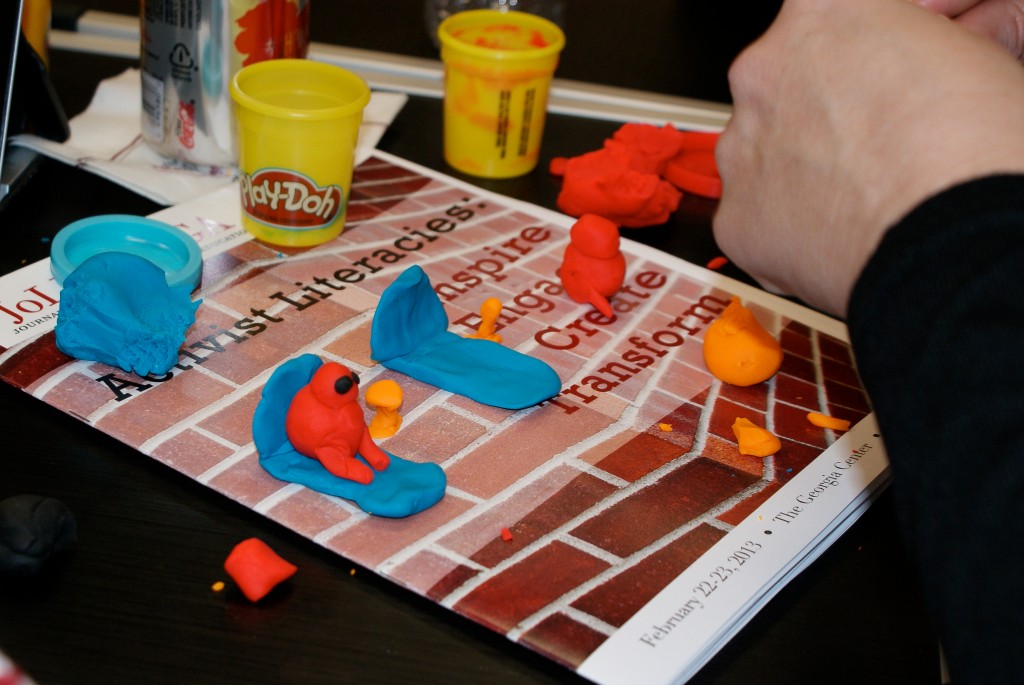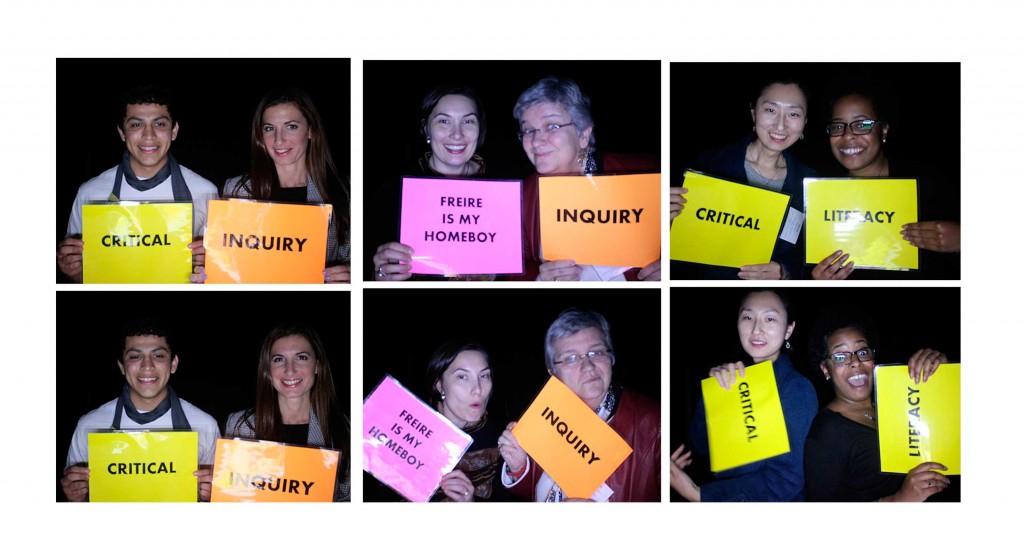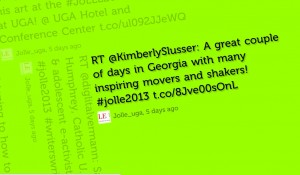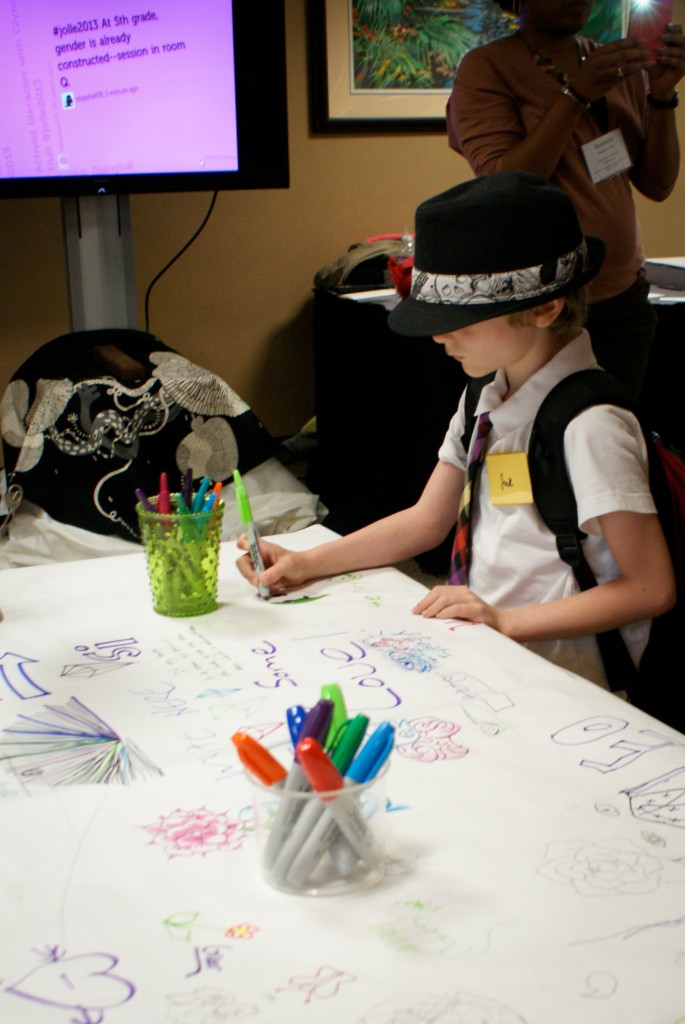
Meghan and other participants at the conference create a tableaux.
Photo by Steven Landry.
Discomfort and an Identity Shift
Meghan B. Thornton
Going into the Activist Literacies conference held by the Journal of Literature and Language Education (JoLLE) at UGA, I was a bit wary. I was sure that if I sat through another workshop touting the benefits of an alphabox or a new design for literature circles, I would quietly stand up, collect my belongings, and drive the six hours back to North Carolina. Well, maybe not so quietly. Instead, what I found at JoLLE was a necessary discomfort. The conference focus on redefining the term “literacy” forced me to question not only what and how I teach, but why! After two days of equal amounts frustration and enthusiasm, I realized I needed to rethink my comfort zone and my identity as a teacher.
Like so many reading and writing teachers, my comfort zone lies nestled in the world of written words. Student reads book, student responds in essay. Words, words, words. But in a world where people communicate more through face-to-face meetings and presentations, video, and even picture, written words have become less integral to the effective communication of meaning. JoLLE forced me to question: is my “word-centric zone” adequately preparing students to communicate meaning in the modern world? The first step in breaking out of my word comfort zone was in Talia Pura’s (2013) session on creating theatre for social change. Through the use of tableaux in the classroom, students can make the abstract more concrete. Such mental and physical discomfort in the classroom pushes students to think more deeply about the conflicts and themes in a text and their possible real-world implications. Suddenly, education shifts from passive acceptance of information to a contact sport. Students are pushed beyond their comfort zones and into a zone of questioning, frustration, and (perhaps, eventually) activism. Is this expression not more immediate, engaging, and potentially memorable than a written reflection?
Digital storytelling was a common thread throughout the conference. For me, digital storytelling was something I had heard of, but couldn’t pick out of a crowd. What I found was that through digital storytelling, teachers and students can create powerful meaning through spoken word, music, and pictures. Visual response methods, such as these, prompt students to focus on meaning in text, without allowing language to get in the way. Barbara Pace (2013) shared multiple digital stories in her session, explaining how such stories can be used by teachers to explain and introduce an abstract concept, but also how students can use digital stories to explore the deeper meaning of “story” rather than simply following a plot line through the events of the text. Thus, students are challenged to find “the story core” in traditional, written stories, as well as the multimedia world they experience on a daily basis.
Not only has my comfort zone now expanded to incorporate acting and digital storytelling, but I am also realizing that part of being a literature teacher is teaching students to become media literate, as well. I have always found ways to bring video clips, commercials, and music into my classroom, but never have I overtly taught students the vocabulary necessary to analyze and talk about such media. In Kathy Garland’s (2013) session on playing with media in school, she emphasized the need to teach our students the terminology necessary to a meaningful discussion of media. Knowledge of the most common shot types in film, for instance, can help students understand perspective. Furthermore, in comparing two different representations of a text, students can discuss how writers and film editors create meaning and emphasis in different ways. No longer can the literature teacher live simply in the comfortable world of words.
Instead, teachers must expand their understanding of “literacy” to incorporate the media as well. As a literature teacher I love to read, and read often. However, after JoLLE’s conference it became very clear that my reading needs to extend beyond the young adult literature that I teach. I work daily to cultivate lifelong readers and learners. Yet, I have left myself out of this mission. I need to start seeing myself as a student, in constant need of information and inspiration.
During the conference, I was intrigued by the idea of multimodal literacies. As a digital native, technology use in the classroom is fairly natural for me. However, in my reading after the conference, I started to see how my idea of technology use was a bit antiquated. Rather than saving technology for “special assignments” or one big project each year, it needs to be an organic part of the classroom. Students need to feel that they are part of a community of readers, writers, and thinkers. They need to develop meaning out of text through collaboration. Upon leaving our classrooms, students will be expected to synthesize gross amounts of information (from a variety of texts and media) and then efficiently share that information on a digital platform. If teachers are to prepare adequately students for this challenge, then they must routinely use modern technology and authentic, engaging lessons and assessments to push students to think more deeply and critically about the material they read and experience. Without considering themselves students as well, teachers will become the roadblock for their students, preparing them for a world that is ten years out of date.
I, like many teachers, attend a lot of workshops and training. Rarely are current researchers in the field presenters at local conferences. Furthermore, after five years of conferences, workshops, and seminars, I find my interest at such events waning. Not because I don’t want to learn new ways to teach my students in an engaging and rapidly changing world, but because the information presented at such conferences is redundant. If our teachers are to maintain their professionalism in the field and prepare students for the technology-focused world of immediate information, then ongoing teacher training needs to reflect this changing landscape.
While professional development should be altered, teachers needn’t wait passively to be informed by others of new trends. Teachers must experience physical and mental discomfort and become activists for literacy. Where the availability of new research is lacking, teachers must take it upon themselves to become students and seek out the current research and technologies they need. Conferences such as JoLLE’s Activist Literacies need to play a more central role in the professional development of teachers. Such conferences challenge teachers to question whether or not they are adequately preparing their students, and give them the tools to start making necessary changes and improvements to their curriculum and methodologies. Next year, when I attend JoLLE’s conference again, I hope to see more uncomfortable practicing teachers in attendance, working to become activists for literacy by redrawing their comfort zones and considering new identities as students themselves.
References
Garland, K. (2013). Expanding teacher’s literacy: Playing with media in school. Session presented at the JoLLE Spring Conference, Activist Literacies: Inspire, Engage, Create, Transform, Athens, GA.
Pace, B. G. (2013). Expanding teacher’s literacy: Digital storytelling in a third space. Session presented at the JoLLE Spring Conference, Activist Literacies: Inspire, Engage, Create, Transform, Athens, GA.
Pura, T. (2013). Creating theatre for social change. Session presented at the JoLLE Spring Conference, Activist Literacies: Inspire, Engage, Create, Transform, Athens, GA.
Megan Thornton is a high school teacher at Endeavor Charter School in Raleigh, North Carolina. She can be reached at meghan824@gmail.com.
